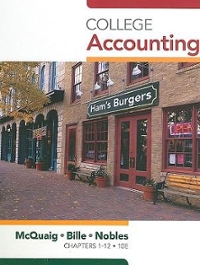Question
UNIT 4 VARIANCE ANALYSISdemonstrate your proficiency in the following course competencies and assignment criteria: Competency 3: Apply quantitative models to manage budgets and forecasts.Calculate price
UNIT 4 VARIANCE ANALYSISdemonstrate your proficiency in the following course competencies and assignment criteria:
- Competency 3: Apply quantitative models to manage budgets and forecasts.Calculate price and efficiency variance.
- Interpret the significance and causes of a price and efficiency variance.
- Describe how a variance analysis can assist in managing budgets and forecasts.
- Competency 5: Communicate in a manner that is consistent with the expectations of a business professional.Communicate in a manner that is consistent with the expectations of a business professional.
Overview
Variance analysis is a technique used to analysis budget performance; it is used to compare budgeted and actual results. Based on the analysis, management can determine operational areas that need to be investigated or potentials changes to future budgets. You will put this into practice in this assignment.
Use the background information presented below variance analysis and PRESENT a three page memo to management describing your conclusions.
Background
Weaver Industries produces storage tanks for the oil and gas industry. Maria Jones, the corporate controller, is not satisfied with the standard costing system of the organization.
The standard cost information given below was derived from consultants hired by Weaver Industries in the prior year. Jones has been observing operations and believes the standard costs are not accurate as the factory workers have a lot of idle time and she seldom observes material unfavorable variances.
Budgeted direct material and labor costs:
- Containers produced: 5000.
- Direct materials price per square feet:Aluminum: $2.75.
- Plastic: $1.25.
- Direct materials per unit:Aluminum (square feet): 18.
- Plastic (square feet): 6.
- Direct labor hours per unit: 2.1.
- Direct labor cost per hour: $11.80.
Actual amounts:
- 4,600 containers were actually produced.
- Cost of aluminum: $282,000 (95,593 square feet).
- Cost of plastic: $49,170 (32,400 square feet).
- Direct labor cost for the containers were $117,000 (9,810 hours).
- No beginning or ending direct material inventory was on hand.
Instructions:
- Calculate the price and efficiency variance for the containers for aluminum, plastic, and direct labor.
- Using the completed analysis, create 3"5 memo to the company's CEO that addresses the following:Provide an interpretation of the variance.
- Identify some of the potential causes of the variances.
- Describe how this variances analysis can assist management in controlling and forecasting future costs.
Step by Step Solution
There are 3 Steps involved in it
Step: 1

Get Instant Access to Expert-Tailored Solutions
See step-by-step solutions with expert insights and AI powered tools for academic success
Step: 2

Step: 3

Ace Your Homework with AI
Get the answers you need in no time with our AI-driven, step-by-step assistance
Get Started


